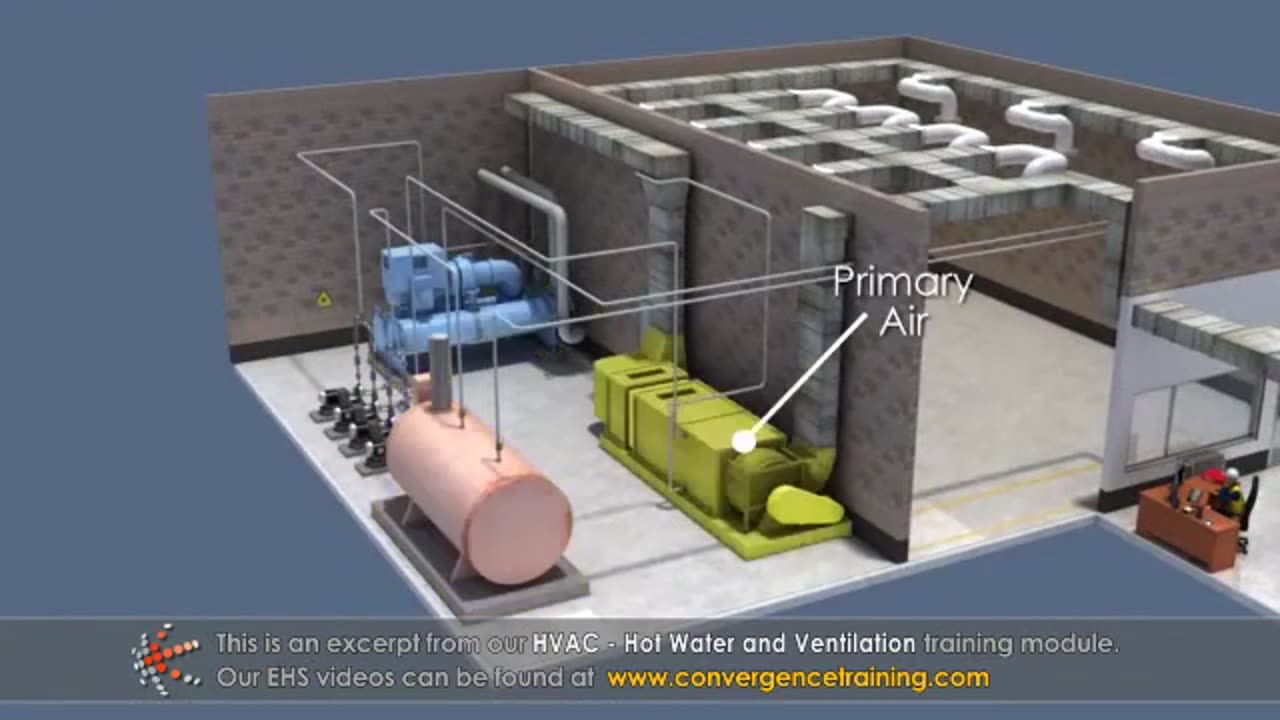Premium Only Content

HVAC - Hot Water and Ventilation
**HVAC (Heating, Ventilation, and Air Conditioning)** systems are essential for maintaining a comfortable and healthy indoor environment. They are designed to regulate temperature, humidity, and air quality within buildings. Two key components of HVAC systems are **hot water** systems (for heating) and **ventilation** systems (for air exchange). Here’s an overview of both:
---
### **1. Hot Water Systems in HVAC**
Hot water is used primarily for space heating and providing hot water for domestic use. HVAC systems typically use hot water through **hydronic heating** to distribute heat in buildings. Hot water systems offer efficient and comfortable ways to manage indoor temperatures, especially in colder climates.
#### **A. Hot Water Heating Systems**
1. **Hydronic Heating (Hot Water Radiators)**
- **How It Works:** Water is heated by a boiler and circulated through pipes to radiators or underfloor heating systems. The radiators then release heat into the room via convection and radiation.
- **Advantages:** Even, gentle heat distribution; energy-efficient, especially when using high-efficiency boilers.
- **Applications:** Common in residential and commercial buildings, especially in regions with cold winters.
2. **Boiler and Radiator Systems**
- **Boiler:** A device that heats water and is typically fueled by natural gas, oil, or electricity.
- **Radiators:** Mounted on walls, they provide warmth by transferring heat from the hot water circulating inside them.
- **Controls:** These systems often use thermostats to control the water temperature and room temperature.
3. **Underfloor Heating**
- **How It Works:** Heated water flows through pipes embedded in the floor, warming the room from the ground up.
- **Advantages:** Provides even heat distribution, and the heat naturally rises. It’s a comfortable solution for homes and offices.
- **Applications:** Residential floors, bathrooms, kitchens, and commercial spaces.
#### **B. Hot Water for Domestic Use**
- **Water Heaters (Tank or Tankless):** These systems provide hot water for domestic needs, such as showers, sinks, and other appliances.
- **Tank Water Heaters:** Store a large volume of heated water for on-demand use.
- **Tankless Water Heaters:** Heat water on demand, providing continuous hot water without the need for storage.
- **Boilers:** Some larger HVAC systems use the same boiler for both heating and domestic hot water.
---
### **2. Ventilation in HVAC**
Ventilation is crucial for providing fresh air, removing stale air, and maintaining air quality within a building. It helps regulate humidity, removes odors, and prevents the buildup of harmful substances like carbon dioxide or volatile organic compounds (VOCs).
#### **A. Types of Ventilation Systems**
1. **Natural Ventilation**
- **How It Works:** Relies on natural forces like wind and temperature differences to circulate air through windows, vents, and building openings.
- **Advantages:** Low energy consumption, promotes passive cooling.
- **Disadvantages:** Less control over air quality and temperature, especially in extreme climates or sealed buildings.
2. **Mechanical Ventilation**
- **How It Works:** Uses fans, ducts, and motors to move air in and out of the building. It can be combined with air filtration systems to improve air quality.
- **Types:**
- **Exhaust Ventilation:** Removes indoor air, typically from bathrooms, kitchens, or industrial areas.
- **Supply Ventilation:** Brings fresh outdoor air into the building while keeping the indoor air under pressure.
- **Balanced Ventilation:** Both exhaust and supply air are mechanically controlled to maintain a balanced airflow.
3. **Heat Recovery Ventilation (HRV) and Energy Recovery Ventilation (ERV)**
- **How They Work:** Both HRV and ERV systems exchange heat and moisture between the incoming and outgoing air streams, maintaining indoor air quality while saving energy.
- **HRV:** Focuses on transferring heat. Ideal for cold climates where heating is important.
- **ERV:** Transfers both heat and moisture, making it beneficial in both hot and humid climates where humidity control is crucial.
#### **B. Ventilation in Different Systems**
1. **Centralized Air Handling Units (AHU)**
- **How It Works:** These units are responsible for regulating both the temperature and ventilation of a building. They are equipped with heating and cooling coils, fans, and filters.
- **Application:** Common in large commercial or industrial HVAC systems, providing controlled ventilation, heating, and cooling across the building.
2. **Ductwork**
- **How It Works:** Ducts are used to distribute heated or cooled air, as well as to bring fresh air in and vent out stale air. Duct systems are typically insulated to prevent heat loss or gain.
- **Types of Ducts:**
- **Flexible Ducts:** Easy to install and suitable for smaller spaces.
- **Rigid Ducts:** Provide better airflow and are more durable, used in larger installations.
3. **Air Filtration**
- **How It Works:** Air filters are used to trap dust, pollen, mold spores, and other contaminants from the air before it enters the indoor environment.
- **Types of Filters:**
- **Mechanical Filters:** Remove particles from the air by trapping them in a mesh.
- **Electrostatic Filters:** Use electric charges to attract and trap dust particles.
- **HEPA Filters:** High-efficiency filters that remove 99.97% of particles as small as 0.3 microns.
---
### **3. Combining Hot Water and Ventilation in HVAC**
In modern HVAC systems, hot water and ventilation are often integrated for energy efficiency and comfort:
- **Combined Hydronic and Ventilation Systems:** A hydronic system can be linked with an air handling unit (AHU) to supply heat to the air and distribute it through ducts.
- **Fresh Air Preheating:** In cold climates, outdoor fresh air can be preheated by circulating it over a hot water coil or through a heat exchanger connected to the boiler system. This reduces the load on heating systems during colder months.
- **Humidity Control:** Energy recovery systems (ERVs) can help control both heat and humidity, maintaining comfortable indoor air quality.
---
### **4. Advantages of Hot Water and Ventilation Integration**
- **Energy Efficiency:** Heat recovery and ventilation systems help conserve energy by using waste heat from exhaust air to preheat incoming air.
- **Comfort:** A properly balanced HVAC system ensures consistent temperatures and adequate airflow throughout the building.
- **Indoor Air Quality (IAQ):** Proper ventilation removes excess moisture, pollutants, and odors, contributing to healthier living and working environments.
- **Cost-Effectiveness:** Well-designed systems reduce the need for constant heating and cooling, lowering operational costs.
---
### **5. Maintenance Considerations**
- **Hot Water Systems:** Regular maintenance is required to ensure the efficiency of boilers, pipes, and radiators. This includes checking for leaks, sediment buildup, and ensuring the correct pressure in the system.
- **Ventilation Systems:** Ducts and filters should be inspected regularly for dust or blockages. Fans and air handling units should also be serviced to maintain optimal airflow.
---
### **Applications of Hot Water and Ventilation in HVAC**
- **Residential Homes:** Hydronic heating systems and mechanical ventilation are used to provide comfort and air quality in homes, particularly in colder climates.
- **Commercial Buildings:** Larger systems integrate hot water for space heating and ventilation for air quality control.
- **Industrial Settings:** Hot water is often used for heating, while ventilation ensures the removal of harmful fumes, gases, and excess heat from factory floors.
---
By understanding how hot water and ventilation systems work together in HVAC, you can optimize comfort, efficiency, and air quality within a building while reducing energy costs and improving sustainability.
-
 7:58
7:58
HSESafetyInformation
2 months agoAuthentic Peshawari Rosh _ Namkeen Gosht Recipe __ Traditional KPK and Baluchistan
611 -
 1:15:07
1:15:07
Ami's House
12 hours agoWhat an ACTUAL Military Expert Thinks of the War in Gaza – Nick Freitas | FULL EP
2.41K3 -
 2:54:02
2:54:02
TimcastIRL
3 hours agoLiberal Media CAUGHT In BOGUS LEAK, Trump DID NOT Fire Mike Waltz, HE PROMOTED HIM | Timcast IRL
130K81 -
 LIVE
LIVE
MyronGainesX
11 hours ago $2.15 earnedSam Seder Embarrasses Ethan Klein, The Truth On MLK's Murder, And Trump's First 100 Days In Review
3,249 watching -
 DVR
DVR
Man in America
7 hours agoEXPOSED: How Militaries Worldwide Are Engineering DEPOPULATION w/ Todd Callender
10.7K8 -
 LIVE
LIVE
SpartakusLIVE
5 hours agoNEW Update, NEW Weapons, NEW META?!? || Quads in VERDANSK
151 watching -
 LIVE
LIVE
Jokeuhl Gaming and Chat
2 hours agoEmpyrion - Galactic Survival Long Range Jump Aquired
68 watching -
 4:42:30
4:42:30
Right Side Broadcasting Network
1 day agoLIVE REPLAY: President Trump Gives Commencement Address at University of Alabama - 5/1/25
136K18 -
 16:58
16:58
T-SPLY
9 hours agoDems’ Bad News: El Salvador Rejects Abrego, Democrats Fume!
51.1K49 -
 18:56
18:56
Nick Shirley
5 hours ago $1.42 earnedAsking People About Trump’s First 100 Days… How are Americans Feeling?
16.2K19